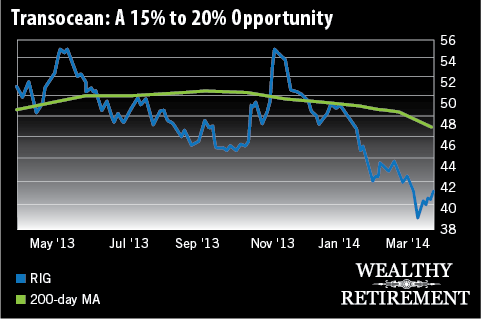 In this market, I won’t consider any stock unless it is a screaming bargain.
In this market, I won’t consider any stock unless it is a screaming bargain.
I’m a bond guy. I’ve proven that it’s possible to beat the markets and not lose the safety of bonds.
So, I should really say, if there isn’t blood flowing under the doors in the executive suite of a company because a stock has been beaten up so badly, as far as I am concerned it’s overpriced.
[ad#Google Adsense 336×280-IA]But there is always an industry, sometimes an entire sector, that is in “blood under the door” mode.
I’ll show you what I mean in just a moment.
And the best part of this bloody buying strategy for stocks is the market usually drops these bargains right in your lap.
Three Distinct Advantages
As with all strategies that work, this one requires patience and discipline.
So most small investors won’t use it.
But it’s a lot more reliable than overpaying for stock, which after a five-year run in this market is all too easy to do.
My unwillingness to buy into what most consider “fairly priced” or “below market” stocks is the direct result of having my head handed to me too many times in sell-offs and corrections over the last 30 years.
And buying stocks this way gives investors three distinct advantages in this market:
- It eliminates the small investor’s most common error, buying high and selling low.
- It keeps the little guy out of the herd mentality of running from bargains and paying too much for yesterday’s winners.
- The lower the stock price, the higher the dividend yield.
Letting the market drop bargains in your lap is a lot different from trying to time the market. I am not a market timer. I know it doesn’t work. The bloody buying strategy is about developing the market sense to know when a stock has been oversold or overbullied by the money press.
Let’s look at an example.
A Double-Digit Opportunity
The Swiss offshore drilling company Transocean (NYSE: RIG) fits all my criteria for a bloody stock with huge potential. It is off 26% from its 52-week high and has a 5.4% dividend.
There are lots of reasons the stock is this low.
Transocean was one of the key players in the Gulf of Mexico oil spill disaster. That event had gallons of red flowing at the home office.
Demand for the type of drilling Transocean does, offshore, is still in question for 2014. That hasn’t helped its stock price.
Transocean has been known in the industry as too conservative and unwilling to step up to more speculative projects with higher risk. This has kept it out of many opportunities that have been snapped up by its competition, Seadrill (NYSE:SDRL) and others. This has hurt its numbers, too.
Analysts are also taking a cautious approach to the offshore drillers as a whole. But a recent Barron’s article called for a bottom in the offshore rig count and a recovery this year. They expect the recent pain in the rig count to be short lived.
I agree.
Essentially, Transocean has been the conservative offshore driller and the laggard in the group, but all indications are this is changing.
Transocean is modifying its entire approach to the offshore market. Barclays described it as becoming a progressive contract driller that’s taking the necessary steps to improve its cost structure and asset quality. It’s also increasing the number of speculative drilling projects.
This, combined with a new cost-cutting program and an evolving strategic mindset, tells me the company is turning the corner and this laggard is about to become a top performer.
The earnings and revenue numbers for this and next year are still weak. Earnings are only expected to increase from $4.67 per share this year to about $4.80 next. And revenues are only expected to increase by about 3%.
That’s not earth-shattering.
But keep in mind, these numbers are based on a very negatively anticipated rig count. As the offshore rig count increases, look for these numbers to be adjusted upward.
The 200-day moving average chart below tells the whole “buy when there’s blood in the executive suite” story.
 In this market you’d be hard-pressed to find a chart with this kind of spread between the stock price and the 200-day moving average.
In this market you’d be hard-pressed to find a chart with this kind of spread between the stock price and the 200-day moving average.
That’s a 15% to 20% move in the near term!
While this is a turnaround story, I don’t consider it a high-risk turnaround. This is a $14.5 billion company that is ranked as one of the leaders in the industry with a profit margin of almost 15% and a return on equity of almost 9%.
The best part, we are getting it at a fire-sale price with a hefty dividend of 5.4%.
Despite all the news about fracking here in the U.S. and the negative news about offshore drilling since the Gulf disaster, offshore drilling is still in high demand and will continue to be a primary source to feed the world’s unending demand for energy.
Obviously, you want a company that isn’t suffering from a terminal issue and, ideally, it pays a dividend. Four or five percent a year goes along way while you wait for a turnaround. And Transocean will be one of the key players for many years to come. It’s one example of what I call a screaming bargain.
— Steve McDonald
[ad#IPM-article]
Source: Wealthy Retirement


